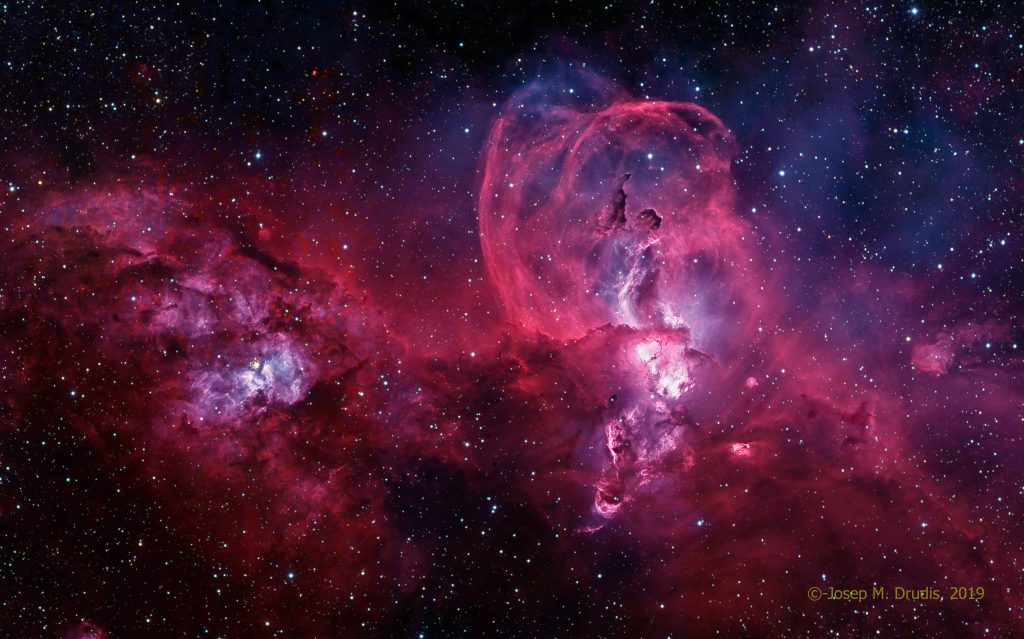
In this 2-pane mosaic, NGC 3576 (right side of the image) is shown together with NGC 3603, the nebula located immediately left of NGC 3576. Both nebulas are completely unrelated, being NGC 3576 at an approximate distance of 9,500 light years, while NGC 3603 is more than twice that distance (about 20,000 ly). This picture has been taken exclusively with narrowband filters (5nm Halpha, 3nm OIII and 3nm SII, RGB having only been used to image the stars) and processed in a way as to reproduce the visible spectrum of this nebula. NGC 3576 is known as Statue of Liberty, a name that was first used by Dr. Mazlin due to the shape of its central part.
NGC 3576 (as well as NGC 3602) is a large emission nebula and an active star formation region, more than 100 light years across. Would it be at the Orion nebula distance (8 times closer), this nebula would span more than 4 degrees in the sky (eight times the full Moon). In this nebula can be found many Bok globules (seen as small dark nebulae, the Bok globules typically have a mass of about 50 solar masses and are the birthplace of many massive stars). NGC 3576 is part of the Carina nebula complex and it shows complex loops. According to the General Catalogue of Herbig-Haro Objects (Reipurth+, 1999), there are no Herbig-Haro objects in this nebula. There are two of them (HH 137 and HH 138) just outside this field, immersed in a dark nebulosity that prevents them to be easily imaged.
As it can be seen in the annotated copy below, besides the two main NGC objects, five more can be spotted and correspond to InterStellar Matter (ISM) mostly around NGC 3576. Two planetary nebulae appear in this region (PN G291.4-00.3 and PN G291.6-00.2) located in the upper left region, left of center. This region contains also 9 Wolf-Rayet stars (see WR 42d as an example in the annotated copy), 3 pulsars, 23 masers and 38 identified Molecular Clouds ([NBY2002] MM12 is one example).
Additional Information
Object
Name(s): NGC 3576 and NGC 3603
Type: Emission Nebulae
RA: 11h 13m 09s
Dec: -61º 14’ 43”
Constellation: Carina
Size (arcmin): 16×27 arcmin and 15×10 arcmin resp.
Magnitude: +9.1 both
Distance: 9,500 ly (NGC 3576) and 20,000 ly (NGC 3603)
Image
Date: 2019-05-15 to 2019-05-24
Location: iTelescope.net, SSO near Coonabarabran, NSW Australia
Size (arcmin): 54.1×36.3
Telescope: Planewave CDK 20” f/6.8
Camera: SBIG STX16803 (4096x4096pix)
Guiding: Astrodon MonsterMOAG off-axis guider
Total exposure: 44 hours (Ha: 12.5h; OIII: 11.5 h; SII: 16.5h; RGB: 3.5h)
Processing: CCDStack, Photoshop CC 2019